|
Saifullah Hakro School of Public Affairs Zijingang Campus, Zhejiang University Hangzhou China |
Arif Jameel School of Public Affairs Zijingang Campus, Zhejiang University Hangzhou China |
Abid Hussain School of Public Affairs Zijingang Campus, Zhejiang University Hangzhou China |
Muhammad Asif School of Public Affairs Zijingang Campus, Zhejiang University Hangzhou China |
In Pakistan private banks working known as stress and unhealthy organization. This study has examined the factors in developing a healthy work environment and employee’s productivity. The study was a cross-sectional descriptive design. The total of 201 respondents was covered from 20 different banks. The result showed positive significant between environment factors and employee’s productivity, Supervisor support and employee’s productivity (r=0.936, p<0.01), physical component and employee’s productivity (r=0.918, p<0.01), training development plan and employee’s productivity (r=0.909, p<0.01), one-hour lunch break and employee’s productivity (r=.0942, p<0.01), and performance feedback and employee’s productivity (r=0.914, p<0.01) Table 2.Therefore, the study suggested a comfortable work-related environment and employee’s productivity can be increased if the above factors are practiced in the workplace.
Key Words: Workplace Environment, Supervisor Support, Physical Furniture, Training Development, Lunch Break, Performance Feedback, Employee’s Productivity.
A number of studies have described the environment impacting on employee’s health and productivity. According to (World Bank, 2012, p. 19.) report that Pakistan is under developing country whereas about 22.3% of the population is existing under the poverty line of 1.25 US$ per day and another about 20.5% has been helpless in the country. In addition, about 0.6% of GDP (Pakistan Ministry of Health, 2009, p. 6.) were public health outlays which is abundant poorer than in equivalent countries, and about 75% of health-related expenditures were paid by patients out of pocket. And ILO has been work to Pakistan government for the solving worksite issue, labours rights, and workplace improvement (Abbas, 2015). Pakistan economic survey (PES) of 2016 reported about 10th biggest labour force results in Pakistan in the world (LONGINOS, QADRI, & PARLAKTUNA). And the labour accidental insurances and benefits on death (LONGINOS et al.) and disablement pension have not been covered in Pakistan. And (Organization, 2003) reports that several chronic diseases factors are linked with an unhealthy lifestyle. And few studies showed that mainly workplaces are placed to encourage healthcare because people are pending maximum time there at work (Dishman, Oldenburg, O’Neal, & Shephard, 1998). Similarly, many authors suggested that health behaviour including health can be improved by “Workplace health promotion programs” (L. M. Anderson et al., 2009). The organization health-wellbeing program has been improving employee’s satisfaction, the company’s profile, higher productivity, and declines employee’s sickness, staff’s turnover and absences (Coopers, 2008). And reducing profit and increasing absenteeism has been linked with the unhealthy organization, and business decisions makers’ identified that employee’s satisfied-committed-health can be improved by the healthy workplace organization. (Lyden & Klingele, 2000) Although, output, efficiency, individual health, and worth of work have been affected by the mental-physical condition(Rees, 1997).As well as a number of studies have been predicted of rising health organization (Crant, 1996). Prior studies have described the negative-positive impact of the work environment at the individual level. such as reducing profit and increasing absenteeism (Lyden & Klingele, 2000). And “practitioner publications, such as business and health, predicted that investing in health promotion is a way of boosting employee performance and reducing absenteeism”(Lipold, 2001). Moreover, few studies showed the health complaints associated with indoor air are common in nonindustrial of office worker environments (Organization, 1982) - (Bluyssen et al., 2016). And a study conducted in eight European countries showed that over one-third of office workers report complaints about indoor air quality (Bluyssen et al., 2016) (see also (Magnavita, 2015)). On behalf of some people indoor-air-related health complaints become persistent and (Edvardsson et al., 2008) are associated with impaired quality of life and disability. And these complaints may attribute their symptoms to poor indoor air even in an environment (Van den Bergh, Brown, Petersen, & Witthöft, 2017) that has contaminant levels far below those toxicologically established to cause harmful effects. And quite a few studies showed (Edvardsson et al., 2008) Indoor-air-related symptomatology may persist among some people despite improvements in air quality. In addition, there is an uncompleted debate about the (Norbäck, 2009) theoretical explanations of indoor-air-related conditions. And several studied suggested that negative workplace behavior is reproducing by the workplace bullying in term of a worker always unprotected from abuse others at the workstation (Andrea & Crawford, 1992). And mainly workplace bullying titled workplace mobbing (Leymann, 1996). In philosophy, (Qureshi et al., 2015) at workplace mobbing is measured to remain a dangerous social stressor. Workplace bullying explores a constant including methodical way to protect employees’ psychological harassment of workplace bully, and it is a duty of every organization (Georgakopoulos, Wilkin, & Kent, 2011).In Pakistan, banks works have been stressful and unhealthy work. Stress work and uncomfortable work-related environment may have highly effected to the employee’s health and productivity. In this sector, employee’s work with an unhealthy and uncomfortable environment may have side effected to employee’s health and productivity. Drawing on the prior literature, we describe the helpful factors of developing a work environment health and employee’s productivity in the banks of Pakistan (see the model of the study in figure1).
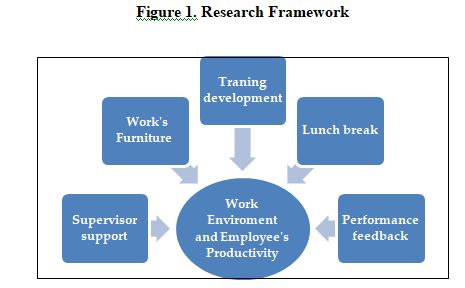
The figure1 showed five-factor was constituted to develop the environment health and employee’s productivity among the banks of Pakistan
The supervisor has experienced (Adair, 1988) ability to solve problems including the role model of the organization management. And (Allen, 2001) supervisor support and Physical workplace environment have been considered environmental factors in an organization. These (Chandrasekar, 2011) factors have been an effect on employee’s performance. Supervisor support (S. E. Anderson, Coffey, & Byerly, 2002) have been decreased work-related family conflict. (Ng & Sorensen, 2008) “Compared the effect of perceived supervisor and coworker support on work attitudes and found that perceived supervisor support was more strongly related to job satisfaction, affective commitment, and turnover intention, as opposed to perceived coworker support”. And, Supervisors support is helpful in controlling work-family’s conflict (Allen, 2001). As drawing on the prior study were developed below hypothesis.
H1 (a). Supervisor’s support helps in developing a healthy work environment in the organization. H1 (b). Supervisor’s support helps in increasing employee’s productivity in the organization
Very few studies suggested that the proper physical structure of the work environment’s (McCoy & Evans, 2005) have been diminishing stress on the job and developed network and relationship. The behavior of work environments component (Haynes, 2008) has impacted more than the physical component. Work-office environment factors have been changing due to some factors such as information technology and innovational changing of organizational work (Hasun & Mohd, 2005).The environment factors have been changed due to business competitiveness in term of employee’s productivity because skilled employees have been lured by a healthy environment. in the organization, the employee’s health has been affected by stress work (Sparks, Cooper, Fried, & Shirom, 1997).job satisfaction has led to the organizational achievement of the task through the help of the working environment (Noah & Steve, 2012).A study suggested that the organization must arrange two elements (Amir, 2010) for achieving their goals, both parts are physical workplace and office comfort. Work environment’s lighting and other furniture factors (Dilani, 2004), positively influenced to employees health including productivity. Work environment factor has been affected to work and relationship with health, facility, and performance (Ettner & Grzywacz, 2001). Hence developed below hypothesis
H2 (a). Physical furniture helps in developing a healthy work environment in the organization. H2 (b). Physical furniture helps in increasing the level of employee’s productivity in the organization
One research has been suggested that monitoring and coaching time and material resources availability (Chandrasekar, 2011) is very important to enable employees to perform to their best of ability. Furthermore, Feedback knowing information (Smither, London, Flautt, Vargas, & Kucine, 2003) regarding the employee’s performance evaluation. According to (Crant, 1996) state that “Feedback seeking is one kind of proactive”. In earlier researches, it has been observed that they are two kinds of motivation linked (Ashford & Tsui, 1991)with feedback seeking which is “performance related and impression management motivation”. “The value of feedback to direct, motivate, and reinforce behavior is well-known (London, 1995). The feedback impactedthe individual levels, such as performance feedback (Kluger & DeNisi, 1996) on employee job performance. As feedback were impacting individually which were leading us below hypothesis
H3 (a). Performance feedback plan helps in developing a level of the healthy work environment. H3 (b). Performance feedback plan helps in developing a level of employee’s productivity.
Well, training (Khan, Ahmad, Iqbal, & Haider, 2014) have a mechanism for organizations objectives to achieve successful results. Few studies have suggested that a positive outcome for both employees and organization (Ward, Haslam, & Haslam, 2008) can be greater than before through the health well-being training program. Similarly, few studies purposed that the positive outcome for employees and organization can be achieved (Price Waterhouse Coopers, 2008) by the well training-policy program. Based on these studied report we perceived the training could lead us below hypothesis as the early study suggested it has numerical effect individually.
H4 (a). Training and development plan helps in developing a level of the healthy work environment. H4 (b). Training and development plan helps in developing a level of employee’s productivity
Few studies have proposed that when the employees’ have been physically and emotionally motivated to work their increased performance result (Boles, Pelletier, & Lynch, 2004). studies have also shown benefits in different memory tasks after sleep compared to time awake (Diekelmann & Born, 2010). During the working period, rest break time aspect knowing a basic part of the work schedule (Brewer et al., 2006), which have been controlled the role of musculoskeletal problems. A study purposed that work-related stress has been connected with less rest break-time (Smith, Leggat, Speare, & Townley-Jones, 2009). Moreover, “an experimental field study demonstrated the effectiveness of incorporating progressive muscle relaxation sessions into lunch breaks in reducing job damage” (Krajewski, Wieland, & Sauerland, 2010). And, (Tietzel & Lack, 2001), reported that “Increased performance in cognitive tasks has been reported to occur within 1 h after a 10-min nap”. And, in the occupational settings, fatness and sleepiness make occupational worse motivation, mood, and job satisfaction, and it leads to poor health results (Willert, Thulstrup, Hertz, & Bonde, 2010). Few studies suggested that a short-term nap improvessucceeding alertness and performance in the day (Gillberg, Kecklund, Axelsson, & Åkerstedt, 1996), and night (Sallinen, HÄRMÄ, ÅKERSTEDT, Rosa, & Lillqvist, 1998).Three qualitative and quantitative study has been reported that the connection of long working week and health symptoms (Sparks et al., 1997). Study on the relationship between working hours and fatigue have been reported that poor work-life balance is caused by long hours working (White & Beswick, 2003). Which are giving us the indication of below hypothesis, this is because break time was effected individually likely fatigue labor and fatigue performance including side effect on health. Hence we intend of these hypothesis in this study.
H5 (a). One hour lunch break time helps in creating a healthy work environment. H5 (b). One hour lunch break time helps in increasing the level of employee’s productivity
The study used depended and independent variables. The dependent variables were employee’s productivity including a healthy environment. And the independent variables supervisor support, physical component, training development, meal breaks, and performance feedback.
The study design was a cross-sectional research. The data was collected by a questionnaire. Total 320 questioners were distributed to different private banks in different cities in Sindh province of Pakistan. Before the survey conducting, 20 envelopes were made in each envelope contained 16 questioners copy. The performance evaluation questionnaires envelope was given to their banks' manager to rate their performance. The questioner envelopes were given to the manager at the official opening time and responded envelopes were received during work closing time on the same day. Total of 201 questioners was successfully filled. The largest number of respondent were collected from 2 cities namely 1=Karachi and 2=Hyderabad which are the biggest cities of Sindh Province. The questionnaire was designed with Likert Scale from 1 to 5 (01 = strongly disagree, 02 = disagree, 03 = neutral, 04=agree and 05= strongly agree).The questionnaire was divided into 2 sections (01 = personal information and 02 = questions section).The largest number of the respondent was from 2 banks 1= Al Habib Bank and 2= Allied Bank. We applied descriptive statistics, such as frequencies, percentages, mean including standard deviation and person correlation. The Microsoft Excel and social sciences (SPSS 16.0) software were used to analyze data in this paper.
|
Gender |
Frequency |
Percent |
Valid Percent |
Cumulative Percent |
|
Male |
186 |
92.5 |
92.5 |
92.5 |
|
Female |
15 |
7.5 |
7.5 |
100.0 |
|
Total |
201 |
100.0 |
100.0 |
|
|
Education |
||||
|
Intermediate |
9 |
4.5 |
4.5 |
4.5 |
|
Bachelor |
65 |
32.3 |
32.3 |
36.8 |
|
Master and above |
127 |
63.2 |
63.2 |
100.0 |
|
Total |
201 |
100.0 |
100.0 |
|
|
Age |
||||
|
20-25 (Years) |
7 |
3.5 |
3.5 |
3.5 |
|
26-35 (Years) |
139 |
69.2 |
69.2 |
72.6 |
|
36-45 (Years) |
50 |
24.9 |
24.9 |
97.5 |
|
Beyond 45 (Years) |
5 |
2.5 |
2.5 |
100.0 |
|
Total |
201 |
100.0 |
100.0 |
|
|
Professional experience |
||||
|
1-5 (Years) |
116 |
57.7 |
57.7 |
57.7 |
|
6-10 ( Years) |
50 |
24.9 |
24.9 |
82.6 |
|
11-15 (Years) |
18 |
9.0 |
9.0 |
91.5 |
|
16-20 (Years) |
12 |
6.0 |
6.0 |
97.5 |
|
21-25 (Years) |
3 |
1.5 |
1.5 |
99.0 |
|
26-30 (Years) |
1 |
.5 |
.5 |
99.5 |
|
Beyond- 31 ( Years) |
1 |
.5 |
.5 |
100.0 |
|
Total |
201 |
100.0 |
100.0 |
|
|
Training plan |
||||
|
Yes |
201 |
100.0 |
100.0 |
100.0 |
|
Lunch break length |
||||
|
Between 1-20 minutes |
150 |
74.6 |
74.6 |
74.6 |
|
Between 21-40 minutes |
45 |
22.4 |
22.4 |
97.0 |
|
Between 41-60 minutes |
6 |
3.0 |
3.0 |
100.0 |
|
Total |
201 |
100.0 |
100.0 |
|
|
Organizations Names |
||||
|
Allied Bank |
63 |
31.3 |
31.3 |
31.3 |
|
Bank Al Habib |
63 |
31.3 |
31.3 |
62.7 |
|
Meezan Bank |
5 |
2.5 |
2.5 |
65.2 |
|
Askari Bank |
3 |
1.5 |
1.5 |
66.7 |
|
Habib Bank |
1 |
.5 |
.5 |
67.2 |
|
Bank Islami |
6 |
3.0 |
3.0 |
70.1 |
|
Silk Bank |
1 |
.5 |
.5 |
70.6 |
|
Sindh Bank |
10 |
5.0 |
5.0 |
75.6 |
|
Summit Bank |
8 |
4.0 |
4.0 |
79.6 |
|
Habib Metropolitan Bank |
3 |
1.5 |
1.5 |
81.1 |
|
Muslim Commercial Bank |
6 |
3.0 |
3.0 |
84.1 |
|
United Bank |
4 |
2.0 |
2.0 |
86.1 |
|
Bank Al Falah |
3 |
1.5 |
1.5 |
87.6 |
|
Faysal Bank |
7 |
3.5 |
3.5 |
91.0 |
|
Samba bank |
4 |
2.0 |
2.0 |
93.0 |
|
Soneri Bank |
5 |
2.5 |
2.5 |
95.5 |
|
Dubai Islamic Bank |
1 |
.5 |
.5 |
96.0 |
|
NIB Bank |
2 |
1.0 |
1.0 |
97.0 |
|
Bank Al Baraka |
1 |
.5 |
.5 |
97.5 |
|
Meezan Bank |
5 |
2.5 |
2.5 |
100.0 |
|
Total |
201 |
100.0 |
100.0 |
|
|
Cities Names |
||||
|
Karachi |
147 |
73.1 |
73.1 |
73.1 |
|
Hyderabad |
27 |
13.4 |
13.4 |
86.6 |
|
Sukkur |
13 |
6.5 |
6.5 |
93.0 |
|
Larkana |
6 |
3.0 |
3.0 |
96.0 |
|
Kamber |
5 |
2.5 |
2.5 |
98.5 |
|
Nawab Shah |
3 |
1.5 |
1.5 |
100.0 |
|
Total |
201 |
100.0 |
100.0 |
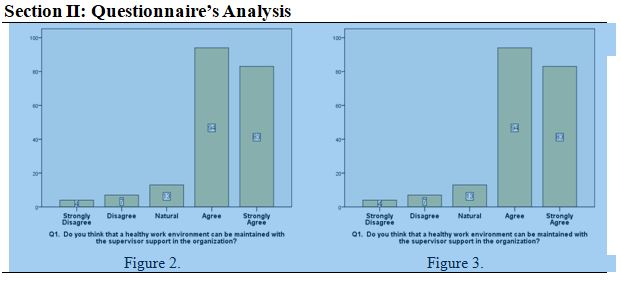
Figure 2 showed4 employees strongly disagree, 7 disagree, 83strongly agree and 94 agree, and 13 natural that supervisor’s support can be developing a healthy work environment in the organization. Similarly, figure 3 showed the4 employees were strongly disagreed, 7 disagreed, 75employees strongly agreed and 90 agreed, and 24 of the natural respondent that employee’s productivity can be increased by the supervisor’s support in the organization.
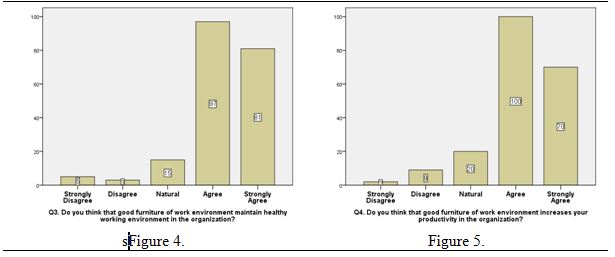
Figure4 showed5 employees were strongly disagreed, 3 disagreed, 81 employees strongly agreed and 97 agreed, and 15 natural respondents that a healthy work environment can be maintained by good furniture. And similarly, figure 5 showed the 2 employees strongly disagree, 9 disagree, 70 strongly agree, 100 agree, and 20 natural respondents that employee’s productivity can be increased if the physical components parts are good.
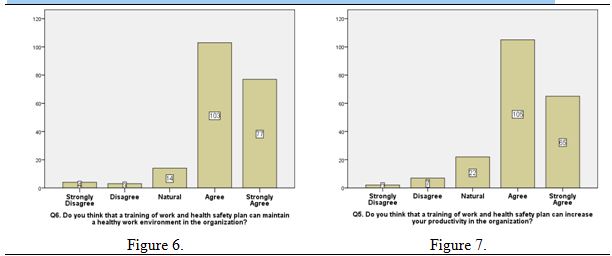
Figure6 shows4 employees strongly disagree, 3 disagree, 77 employees strongly agreed and 103 agree, and 14 natural respondents on the opinion that a work-related health and safety training program can increase the level of a healthy work environment. And while the 2 employees strongly disagree, 7 disagree, 65 employees strongly agree and 105 agree, and 20 of natural respondents that employee’s productivity can increase by training development program figure 7.
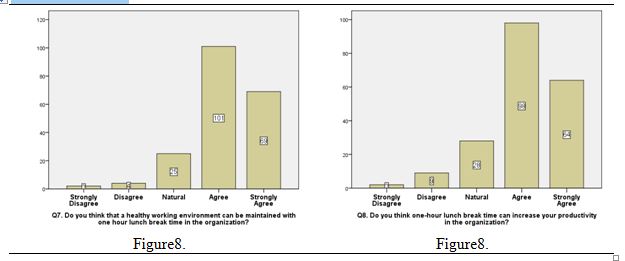
Figure8 shows2 employees strongly disagree, 4 disagree, 69 employees strongly agree and 101 employees agree, and 25 natural respondents with an opinion that “one-hour lunch break” can play a role in developing a healthy work environment. And 2 employees strongly disagree, 9 disagree, 64 strongly agree and 98agree and 28 natural respondents with the statement that employee’s productivity can increase if the “one-hour lunch break time” is praised in the organization figure 9.
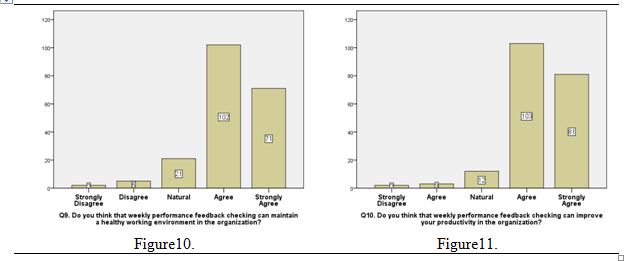
Figure10 shows 2 employees strongly disagree, 71 employees strongly agree and 102 agree, and while the 21 of natural respondents with the statement that “weekly performance feedback plan” can be to maintain a healthy work environment. Figure11 shows 2 employees strongly disagree, 3 disagree,81 employees were strongly agreeing and 102 agree, and 12 of natural respondents that weekly performance feedback plan increaseemployee’s productivity in the organization
The result shows of person correlation between environmental factors and employee’s productivity positive significant relationship between factors and employees productivity.
Table 2: Pearson Correlation Sig. (2-tailed) |
R |
P |
Supervisor support |
.936** |
.000 |
Work environment furniture |
.918** |
.000 |
Training development |
.909** |
.000 |
Lunch break |
.942** |
.000 |
Performance feedback |
.914** |
.000 |
**. Correlation is significant at the 0.01 level (2-tailed).
Supervisor support and employees productivity (r=0.936, p<0.01), relationship between physical component of environment and employees productivity (r=0.918, p<0.01), work-related health safety and training development plan and employees productivity (r=0.909, p<0.01), one-hour lunch break time and employees productivity (r=.0942, p<0.01), and Performance feedback plan and employees productivity (r=0.914, p<0.01) Table 2.
|
Table 3: Mean and Std. Deviation |
|||||
|
Questions |
Total |
Minimum |
Maximum |
S.M |
S.D |
|
Q1. |
201 |
1 |
5 |
4.22 |
.867 |
|
Q2. |
201 |
1 |
5 |
4.12 |
.892 |
|
Q3. |
201 |
1 |
5 |
4.22 |
.845 |
|
Q4. |
201 |
1 |
5 |
4.13 |
.839 |
|
Q5. |
201 |
1 |
5 |
4.22 |
.803 |
|
Q6. |
201 |
1 |
5 |
4.11 |
.807 |
|
Q7. |
201 |
1 |
5 |
4.15 |
.786 |
|
Q8. |
201 |
1 |
5 |
4.06 |
.852 |
|
Q9. |
201 |
1 |
5 |
4.17 |
.788 |
|
Q10. |
201 |
1 |
5 |
4.284 |
0.7309 |
|
Valid N (list wise) |
201 |
|
|
|
|
The “Sample mean and Standard Deviation” result showed high Simple means score (Q1= S.M 4.22, and S.D, 0.867), (Q2= S.M 4.12, and S.D .892), (Q3= S.M 4.22, and S.D, 0.845), (Q4= S.M 4.13, and S.D, 0.839), (Q5= S.M 4.22, and S.D, 0.803), (Q6= S.M 4.11, and S.D, 0.807), (Q7= S.M 4.15, and S.D, 0.786), (Q8= S.M 4.06, and S.D 0.852), (Q9= S.M 4.17, and S.D 0.788), (Q10= S.M 4.28, and S.D 0.730) Table 3.
Environment highly estimated with employee’s health and productivity. Secure work environment and employee’s productivity is based on different factors. This study described factors of developing a secure environment and its impact on employee’s productivity. The factors were supervisor support, training development, furniture’s, lunch times, and performance feedback. The study shows Majority of the employees agree and strongly agree that employee’s productivity and healthy work environment is increasing with the help of the supervisor’s support Figure2-3.Supervisor support (S. E. Anderson et al., 2002) decreased work-related family conflict. (Ng & Sorensen, 2008) supervisor support doing job satisfaction, affective commitment, and turnover intention. Supervisors support controlling work-family’s conflict (Allen, 2001). A large number of employees agreed and strongly agreed that work-related good furniture develops employee’s productivity and secure environmentFigure4-5.The work environments component impacted more than the physical component (Haynes, 2008). work environment’s lighting and other furniture factors have positively influenced to employees health including productivity (Dilani, 2004). And organization must arrange two elements for achieving their goals, both parts are physical workplace and office comfort (Amir, 2010). Figure 6-7 shows maximum employees agreed and strongly agreed that work-related health and safety training can be developed secure work and employee’s productivity. Training developing trend full workforce to do work safely to avoid waste material. Few studies suggested the positive outcome for employees and organization can be achieved by the well training-policy program (Price Waterhouse Coopers, 2008). Figure8-9 shows the number of the employees strongly agreed and agreed that “one-hour lunch rest breaks time” is helpful in maintaining a healthy environment and employee’s productivity. Mainly in this time office staff is doing a body off from work wherein could doing cleanliness of the working environment during lunch time. In addition, the rest break time is a basic part of any work schedule which controls musculoskeletal problems (Brewer et al., 2006). In the comfortable lunch break time, he/she will get refreshment which could positively impact an employee’s productivity. And a large number of employees responded strongly agree and agree that weekly “performance feedback plan” can maintain a healthy work environment and employee’s productivity Figure10-11. Additionally, these employees were highly professional experienced and educated. The (Smither et al., 2003) Feedback is information about the quality evaluation of the employee’s performance. “Feedback seeking is one kind of proactive (Crant, 1996). Two kinds of motivation linked (Ashford & Tsui, 1991) with feedback seeking which is “performance related and impression management motivation”. Feedback impacts at the individual level as performance feedback on employee’s job performance (Kluger & DeNisi, 1996). The seeking employee’s feedback is to improving his/her outcome which can a better outcome individually. It reminds the employees to adopt great attitude respectively with his/her role in the workplace
This study concluded working environment factors positively impacted on employee’s productivity in the private banks. The study showed a strong positive relationship between factors and employee’s productivity can deal with more number of issues in small organizations regarding the development of employee’s productivity and a healthy working environment. For the organization most important negotiates to manage healthier working environments factors for the employee’s productivity, because a skilled employee preferred the healthy organization. The key findings of this research study are environment factors level motivation, supervisor support, training development program, the physical component of the environment, lunch rest break time’s management, and strategy of performance feedback plan. These factors developed a secure working environment and employee’s productivity in the Banks. Banks should change the strategy to develop a good working environment to employee’s productivity in the banking sector of Pakistan. Moreover, environment style is the key to achieve task efficiently-effectively. Further study suggested a healthy and secure work-related environment may improve employee’s attendance, attitude, and job satisfaction towards the workplace if the current studies factors are praised in the workplace.
• The organization eagle eye to a physical component which increases the degree of comfort ability-performance and productivity. • The organization latest concept of human resources (HR) in developing healthy workforce-healthy working environment. • The organization implement training plan health safety and the control on risk of danger, it utilizes works materials in the proper manner. • The organization must emphasize to employees about health care, this will increase the positive impact on the employees-organization profile. • The organization must make one hour’s lunch break time schedule which improves employee’s physical-mental health and productivity. • The organization must bring the concept of physical checkup in every year to show healthy organization and healthy workforce to catch well experience employee and it to be the positive impact on organization profile and on employee’s productivity. • The organization latest furniture for the work-health facilities increase employees comfortably and productivity. • The organization emphasizes encouraging daily life exercise and made the bonus for employee’s health record in the organization.
Abbas, M. (2015). Trend of Occupational Injuries/Diseases in Pakistan: Index Value Analysis of Injured Employed Persons from 2001–02 to 2012–13. Safety and health at work, 6(3), 218-226. Adair, J. E. (1988). The effective supervisor: Industrial Society Press. Allen, T. D. (2001). Family-supportive work environments: The role of organizational perceptions. Journal of vocational behavior, 58(3), 414-435. Amir, F. (2010). Measuring the impact of office environment on performance level of employees: A case of private sector of Pakistan. Paper presented at the Proceedings of the 2nd International Conference of AGBA South Asia Chapter on Nurturing Innovation, Entrepreneurship, Investments and Public Private Partnership-in Global Environment. Anderson, L. M., Quinn, T. A., Glanz, K., Ramirez, G., Kahwati, L. C., Johnson, D. B., . . . Kalra, G. P. (2009). The effectiveness of worksite nutrition and physical activity interventions for controlling employee overweight and obesity: a systematic review. American journal of preventive medicine, 37(4), 340-357. Anderson, S. E., Coffey, B. S., & Byerly, R. T. (2002). Formal organizational initiatives and informal workplace practices: Links to work–family conflict and job-related outcomes. Journal of management, 28(6), 787-810. Andrea, A., & Crawford, N. (1992). Bullying at Work: How to Confront and Overcome It: London: Virago Press. Ashford, S. J., & Tsui, A. S. (1991). Self-regulation for managerial effectiveness: The role of active feedback seeking. Academy of Management journal, 34(2), 251-280. Bluyssen, P., Roda, C., Mandin, C., Fossati, S., Carrer, P., De Kluizenaar, Y., . . . Bartzis, J. (2016). Self‐reported health and comfort in ‘modern’office buildings: first results from the European OFFICAIR study. Indoor Air, 26(2), 298-317. Boles, M., Pelletier, B., & Lynch, W. (2004). The relationship between health risks and work productivity. Journal of Occupational and Environmental Medicine, 46(7), 737-745. Brewer, S., Van Eerd, D., Amick Iii, B. C., Irvin, E., Daum, K. M., Gerr, F., . . . Rempel, D. (2006). Workplace interventions to prevent musculoskeletal and visual symptoms and disorders among computer users: a systematic review. Journal of occupational rehabilitation, 16(3), 317. Chandrasekar, K. (2011). Workplace environment and its impact on organisational performance in public sector organisations. International Journal of Enterprise Computing and Business Systems, 1(1), 1-19. Coopers, P. W. (2008). Building the Case for Wellness. Health Work Wellbeing. Crant, J. M. (1996). Doing more harm than good: when is impression management likely to evoke a negative response? Journal of Applied Social Psychology, 26(16), 1454-1471. Diekelmann, S., & Born, J. (2010). The memory function of sleep. Nature Reviews Neuroscience, 11(2), 114. Dilani, A. (2004). Design & Health III: health promotion through environmental design: International Academy for Design and Health (IADH). Dishman, R. K., Oldenburg, B., O’Neal, H., & Shephard, R. J. (1998). Worksite physical activity interventions. American journal of preventive medicine, 15(4), 344-361. Edvardsson, B., Stenberg, B., Bergdahl, J., Eriksson, N., Lindén, G., & Widman, L. (2008). Medical and social prognoses of non-specific building-related symptoms (Sick Building Syndrome): a follow-up study of patients previously referred to hospital. International archives of occupational and environmental health, 81(7), 805-812. Ettner, S. L., & Grzywacz, J. G. (2001). Workers' perceptions of how jobs affect health: A social ecological perspective. Journal of Occupational Health Psychology, 6(2), 101. Georgakopoulos, A., Wilkin, L., & Kent, B. (2011). Workplace bullying: A complex problem in contemporary organizations. International journal of business and social science, 2(3). Gillberg, M., Kecklund, G., Axelsson, J., & Åkerstedt, T. (1996). The effects of a short daytime nap after restricted night sleep. Sleep, 19(7), 570-575. Hasun, F. M., & Mohd, Z. (2005). An overview of workplace environment and selected demographic factors towards individual health and performance enhancement. Haynes, B. P. (2008). An evaluation of the impact of the office environment on productivity. Facilities, 26(5/6), 178-195. Khan, N., Ahmad, N., Iqbal, N., & Haider, N. (2014). Relationship of Training and Education with Employee Performance in Financial Institutions. International Letters of Social and Humanistic Sciences, 41, 150-156. Kluger, A. N., & DeNisi, A. (1996). The effects of feedback interventions on performance: A historical review, a meta-analysis, and a preliminary feedback intervention theory. Psychological bulletin, 119(2), 254. Krajewski, J., Wieland, R., & Sauerland, M. (2010). Regulating strain states by using the recovery potential of lunch breaks. Journal of Occupational Health Psychology, 15(2), 131. Leymann, H. (1996). The content and development of mobbing at work. European journal of work and organizational psychology, 5(2), 165-184. Lipold, A. G. (2001). Six ideas to boost employee productivity. Business and health, 19(9), 26-30. London, M. (1995). Giving feedback: Source-centered antecedents and consequences of constructive and destructive feedback. Human Resource Management Review, 5(3), 159-188. LONGINOS, S. N., QADRI, Y. M., & PARLAKTUNA, M. Health and Safety Conditions in Four Major Industrial Sectors of Pakistan from 2010 To 2015. Lyden, J. A., & Klingele, W. E. (2000). Supervising organizational health. Supervision, 61(12), 3-6. Magnavita, N. (2015). Work-related symptoms in indoor environments: a puzzling problem for the occupational physician. International archives of occupational and environmental health, 88(2), 185-196. McCoy, J. M., & Evans, G. W. (2005). Physical work environment. Handbook of work stress, 219-245. Ng, T. W., & Sorensen, K. L. (2008). Toward a further understanding of the relationships between perceptions of support and work attitudes: A meta-analysis. Group & Organization Management, 33(3), 243-268. Noah, Y., & Steve, M. (2012). Work environment and job attitude among employees in a Nigerian work organization. Journal of Sustainable Society, 1(2), 36-43. Norbäck, D. (2009). An update on sick building syndrome. Current opinion in allergy and clinical immunology, 9(1), 55-59. Organization, W. H. (1982). Indoor air pollutants exposure and health effects report on a WHO meeting Nördlingen, 8-11 June 1982. EURO reports and studies, 78. Organization, W. H. (2003). Diet, nutrition, and the prevention of chronic diseases: report of a joint WHO/FAO expert consultation (Vol. 916): World Health Organization. Pakistan Ministry of Health. (2009, p. 6.). National Health Policy 2009: Stepping TowardsBetter Health (draft 19 Feb 2009). from www.pc.gov.pk/Policies/Health.doc PriceWaterhouseCoopers, L. (2008). Building the case for wellness. London: Department for Work and Pensions. Qureshi, M. I., Iftikhar, M., Janjua, S. Y., Zaman, K., Raja, U. M., & Javed, Y. (2015). Empirical investigation of mobbing, stress and employees’ behavior at work place: quantitatively refining a qualitative model. Quality & Quantity, 49(1), 93-113. Rees, K. (1997). Journey of discovery: A longitudinal study of learning during a graduate professional programme (Ph. D. thesis). Case Western Reserve University, Cleveland. Sallinen, M., HÄRMÄ, M., ÅKERSTEDT, T., Rosa, R., & Lillqvist, O. (1998). Promoting alertness with a short nap during a night shift. Journal of sleep research, 7(4), 240-247. Smith, D. R., Leggat, P. A., Speare, R., & Townley-Jones, M. (2009). Examining the dimensions and correlates of workplace stress among Australian veterinarians. Journal of Occupational Medicine and Toxicology, 4(1), 32. Smither, J. W., London, M., Flautt, R., Vargas, Y., & Kucine, I. (2003). Can working with an executive coach improve multisource feedback ratings over time? A quasi‐experimental field study. Personnel Psychology, 56(1), 23-44. Sparks, K., Cooper, C., Fried, Y., & Shirom, A. (1997). The effects of hours of work on health: a meta‐analytic review. Journal of occupational and organizational psychology, 70(4), 391-408. Tietzel, A. J., & Lack, L. C. (2001). The short-term benefits of brief and long naps following nocturnal sleep restriction. Sleep, 24(3), 293-300. Van den Bergh, O., Brown, R. J., Petersen, S., & Witthöft, M. (2017). Idiopathic environmental intolerance: A comprehensive model. Clinical Psychological Science, 5(3), 551-567. Ward, J., Haslam, C., & Haslam, R. (2008). The impact of health and safety management on organisations and their staff. White, J., & Beswick, J. (2003). Working long hours. Health & Safety Laboratory (HSL), Sheffield. Willert, M. V., Thulstrup, A. M., Hertz, J., & Bonde, J. P. (2010). Sleep and cognitive failures improved by a three-month stress management intervention. International journal of stress management, 17(3), 193. World Bank. (2012, p. 19.). Micro Insurance in Pakistan: A Diagnostic Study., from http://www.secp.gov.pk/corporatelaws/pdf/MI Report 16102012.pdf